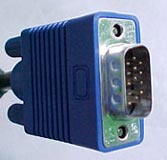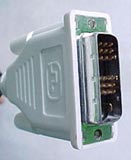Important info about buying a TFT
display
We always suggest you test any flat panel
display you are considering in the store before you pay for it! LCD panels are very complex components and in the past
many manufacturers only guaranteed their display's to be 99.9% free from defect.
That could mean up to 3 or 5 broken pixels before the display is considered
"broken." Broken pixels are individual pixels in the display panel which are
stuck on a certain colour, are constantly dim, or are always off. Depending on
the location and intensity of a broken pixel they can be next to invisible, or
glaringly obvious. It pays to test the display first, regardless of which
manufacturer makes it.
Analog and DVI Standards
| Analog Connection |
DVI Connection |
 |
 |
Analog video
connections are the type of video cable most commonly in use at the moment. In
the future this may change, but for the moment there are still a heck of a lot
of people holding on to their old 17" CRT displays. The 171MP only
offers support for an Analog connection.
The basic differences between an analog display adapter and a DVI (digital) display adapter
is that with the blue analog cable the image is transmitted to your monitor as an
analog signal.
On the DVI it arrives at the display as a digital stream
of one's and zero's. When these display signals are sent to an LCD display - a
device which only operates in the digital realm - the picture must translated to
a digitally signal before it can be processed and displayed.
On the other hand, if you happen to be equipped with a
digital output on your video card, the digital signals are simply sent right to
the display to be shown on the screen as they were intended. Is there a difference between the two
means of connecting a display? No... not really. On the visual level there hasn't
ever been a perceivable difference in display quality that I could actually see.
Six Sets of Cables
Given the
number of signal inputs (for video and audio) on the back of
the display you would expect there to be a separate accessory kit so you can take
full advantage of all the features (like the X-Box and DVD playback for
example).
We've generally seen companies engage in these types of practices because it
is an easy way to grab money, and not get stuck with the cost of including all
the accessories, that only 60%-70% of buyers will actually use.
Contrary to this disappointing trend in the tech
industry we were pleased to see the full complement of cables and connectors
were included with the Syncmaster 171 save for the TV tuner ($90), RCA-DTV &
stereo RCA cables which are the only optional components.
Included with our review display were a;
15-pin analog video cable, s-VHS cable, stereo audio cable, RCA (left, right,
video) cable, RCA-DTV cable, Stereo-RCA cable, a power cord/AC adaptor, remote,
tuner box, batteries, and some manuals and an installation CD.
